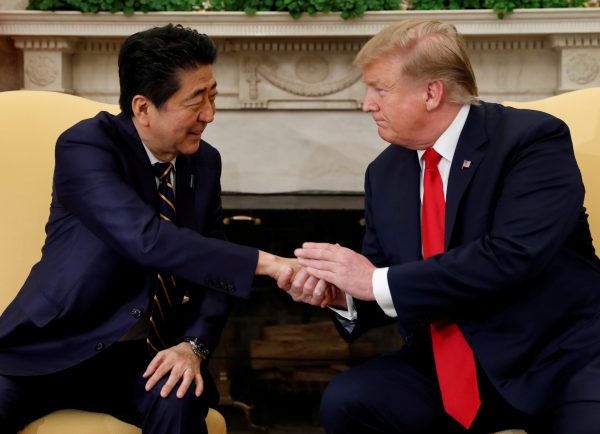The first meeting was held on 27 April following the failure of the second summit between the United States and North Korea in February. Abe sought reassurance from the United States over North Korea in these negotiations. Although North Korea launched short-range missiles after Abe’s visit to the United States, both Trump and Abe still seem to hold relatively generous attitudes towards North Korea. The second meeting is Trump’s visit to Japan from 25 to 28 May. The third meeting is the 28–29 June G20 summit in Osaka.
So why has Trump been invited to Japan a month before the G20? On 1 May, Emperor Naruhito ascended the Chrysanthemum Throne, heralding the Reiwa era. Obviously, Abe is on the ‘charm defensive’ in asking Trump to meet with Japan’s new emperor before any other leaders, including China’s President Xi Jinping, whose upcoming attendance at the Osaka G20 marks his first visit to Japan. Japan originally planned to welcome Xi as a state guest this June, but this was postponed due to escalations in the US–China trade war.
Showing his positive reception of Abe’s forward approaches, Trump expressed in a press conference his desire to wrap up the trade agreement with Japan as soon as possible. Strangely though, President Trump (intentionally or unintentionally) stated that the United States has not imposed any tariffs on Japanese cars. The truth is that Japan has not imposed tariffs on US cars, but the United States imposed a 2.5 per cent tariff on Japan’s. Some media outlets in the United States omitted Abe’s uncomfortable correction, and Trump’s statement has become an unfortunate sound bite.
Japan is, of course, nervous about the possibility that the United States is looking to increase tariffs on cars to 25 per cent. 18 May was the original deadline for Trump to make this decision under Section 232 of Trade Expansion Act. However, Abe’s efforts might work somehow, and 180 extra days may be given to Japan, the European Union and South Korea before Trump decides on new automobile tariffs in order to come to a deal that would ‘limit or restrict’ exports of automobiles, according to a draft of a Presidential Order on 17 May.
Trump’s tweet bombs are also putting pressure on Japan. On 5 May, Trump suddenly announced that the United States will increase almost all trade war-related tariffs from 10 per cent to 25 per cent. China is now trying to fight back, increasing its retaliatory tariffs on US goods, although this will likely do more damage to China than to the United States. Trump has stated that he is looking to negotiate with Xi on the side lines of the G20 summit.
The situation now resembles a game of pinball. The United States is adding pressure to its requests that Japan disassemble trade barriers on agricultural products from the United States, as Trump mentioned specifically in his last meeting with Abe. In the midst of the 2018 US mid-term elections, China specifically targeted tariffs on products from the ‘red states’ and the ‘farm belt’ where Trump supporters are concentrated.
The United States faces huge disadvantages in its primary goods exports and is looking to close the gaps. One instance is the increasing competitiveness of Australian beef over US beef, given Australia’s place as a member country of the Comprehensive and Progressive Trans-Pacific Partnership (CPTPP). As many predicted, Trump’s decision to withdraw from the TPP following his inauguration has mostly just served to exclude the United States.
Last but not least, Japan will also have its upper house election in July. The three closely successive meetings and Abe’s charm diplomacy through asking for the new emperor must be seen as key lifelines for him to protect his party from the uncertainties of the Trump era.
Dr Asuka Matsumoto is an Assistant Professor in the Department of Policy Studies at Doshisha University, Kyoto.

